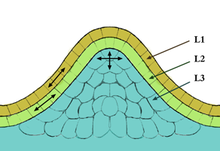Tunica (angiosperms)
As a tunica ; Cover , covering layer , membrane (tissue layer) are called cells in the cover seed plants, which are in the outer area of the apical and subapical meristem tissue . These cells can only anticlinal (vertical) share . The leaf systems as well as the epidermis and the outer layers of the bark arise from the tunica .
Onions and tubers often have protective outer shells made of dead material - these are also known as tunics . Usually such a tunica is derived from the bases of dead leaves. More generally, any leaf sheath or protective leaf that sticks to the plant after the leaf dies can be called a tunica.
An old name for the seed coat was also tunica.
The old generic name of rock carnations was Tunica Mert. & WDJKoch .
literature
- Kück and Wolff: Basic botanical internship. 2nd edition, Springer, 2009, ISBN 978-3-540-88648-8 .
- Günter Throm: Basics of botany. 2nd edition, NIKOL, 2007, ISBN 978-3-937872-61-2 .
Individual evidence
- ↑ Benjamin Daydon Jackson : A Glossary of Botanic Terms with their Derivation and Accent. 4th Rev. Ed., Gerald Duckworth & Co., London 1928, p. 395, archive.org .
- ↑ HA Pierer (Ed.): Universal Lexicon of the Present and Past. Volume 26, 2nd edition, 1845, p. 276, limited preview in the Google book search.
